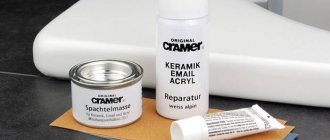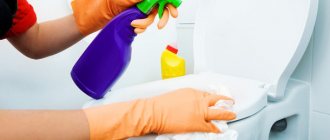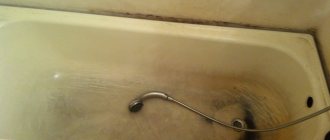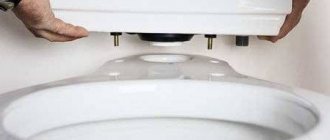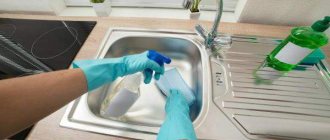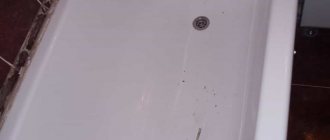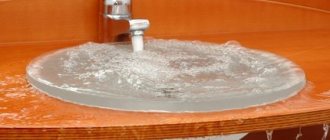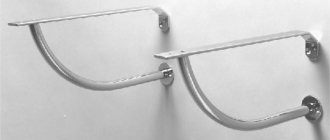There is an opinion that a clean sink and a clean toilet are the face of the housewife, but in fact, not only the reputation of the woman caring for it, but also the health of the household depends on cleanliness. The toilet is a place where pathogenic bacteria constantly accumulate, and the presence of limescale and urinary stone in the drain pipes contributes to this.
There is an opinion that a clean sink and a clean toilet are the face of the housewife, but in fact, not only the reputation of the woman caring for it, but also the health of the household depends on cleanliness. The toilet is a place where pathogenic bacteria constantly accumulate, and the presence of limescale and urinary stone in the drain pipes contributes to this.
Reasons for the appearance of urinary stones on the walls of the toilet
The appearance of urinary stones depends on many factors. The reason may be poor quality of water in the tank, infrequent flushing while using the toilet, a broken tank, old plumbing and poor enamel coating of the drain, or all these reasons together.
Urine stone is a plaque consisting of calcareous and mineral deposits. To a greater extent, the amount of these deposits will depend on the regularity of cleaning the plumbing and on the condition of the pipes; the more rough places there are in the drain pipe, the easier it will be for mineral deposits to settle there, and the thicker the layer of stone will be.
How to clean a toilet from urinary stones
To clean the toilet from corrosive plaque, you first need to remove all existing water from the drain pipe, to do this you need to shut off the access to water and remove the existing water, this can be done using an old ladle, or a jar, a large syringe, a plunger or any other container that can be used you can remove excess liquid from the drain hole.
The presence of water will reduce the effectiveness of stone removal products, so for maximum effect, it is worth fiddling around a little to get the desired result.
Then, carefully protecting your hands from aggressive agents, you need to apply them to the urinary stone, leaving it for a long time, ideally overnight. After some time, the stone is removed with a hard sponge, brush, brush, spatula, possibly a plastic knife or knife, or other thing with a fairly hard surface. However, it is worth considering that by injuring the surface of the drain, the problem with urinary stones will begin to form more often.
Folk remedies
The choice of means to combat stone plaque is quite large; you can use a special solution or gel purchased in the store, or you can choose a remedy from the substances available at home.
What can I use to clear stone from a pipe drain?
Vinegar
Vinegar is found in almost every home; its use is not limited to culinary needs. The scope of its application is quite wide and one of such applications is cleaning the toilet.
In order to clean the toilet drain pipe of plaque, you will need vinegar, about a glass and old rags. It is advisable to heat the vinegar, although you can use a solution at room temperature. Then, after putting on gloves, we generously soak old rags with heated vinegar and place them on the affected areas of the drain. The toilet is closed with a lid and left for a while. The plaque softens under the influence of vinegar and is easily separated from the surface with a spatula or knife.
Review of effective household chemicals
When you see an unpresentable rusty deposit in the toilet, you want to get rid of it quickly. To speed up the cleaning process, you can turn to a range of household chemicals to combat this problem. Moreover, the product for cleaning the toilet from urinary stones should contain on the label the appropriate recommendations for use, since ordinary cleaning compositions for cleaning stoves, sinks, and other things will not be suitable.
Possible options for how to clean a toilet from rust and urinary stone:
- Abrasive compounds . With their help, you can achieve a white surface of a plumbing fixture, however, there are very significant “BUTs”. Firstly, you will have to make a lot of effort, since in this case the plaque is removed using a hard sponge with a product applied to it. Secondly, the result, even the best, will fade very quickly due to the formation of invisible scratches on the surface, which leads to even more intense contamination in the future.
- Wax separately from other products and as an additive to them. When wondering how to clean a toilet from stone, you should know that this method works most effectively on plumbing fixtures with a nickel-plated or chrome-plated surface. In addition, wax helps soften abrasive compounds, so they can be used together to clean the toilet.
- Alkaline products corrode plaque. It is most effective to use them at the initial stage of contamination. Then the result will be a snow-white surface. This is achieved through exposure to caustic sodium present in such products. These include Domestos, Toilet Duck, Comet and other products similar in principle of action. It is recommended that you carry out all toilet cleaning operations while wearing rubber gloves. Such measures will protect the skin from exposure to aggressive substances. When the task is to cope with old plaque, similar means should be used repeatedly.
Household chemicals for cleaning plumbing fixtures - Acidic substances, for example, Cillit are highly effective and can cope with old pollution, however, there is a “BUT” here too. Thus, in terms of the nature of the impact, such products are comparable to abrasive compounds. Accordingly, having been puzzled by the question of how to remove urinary stones in the toilet, you need to mentally prepare for the fact that after using such aggressive substances the surface of the plumbing fixture will suffer - it will become rough, and therefore even more susceptible to the formation of plaque.
Silite is a popular remedy that will help dissolve urinary stones in the toilet.
Important: Acidic products should not be left on the surface for a long time.
As you can see, aggressive substances should be used to remove “difficult” stains, but there is always a risk that they can damage the surface of the toilet. And milder agents are not always effective. Therefore, the choice must be made independently by each user, taking into account the characteristics of the plumbing fixture: type of material, presence of damage, microcracks, degree of contamination.
Whiteness is another effective way to clean the toilet from yellow plaque
Potent chemistry
If the dirt is very old and the layer of limescale is very thick, then strong substances come into play.
Please note that their frequent use is contraindicated!
Hydrochloric acid
The use of hydrochloric acid requires compliance with safety rules. It is not recommended to inhale acid vapors! The use of acid in the presence of plastic pipes is prohibited. The use of protective gloves is mandatory!
The acid is applied to the inner surface of the toilet and under the rim, left for 15 minutes and washed off with a brush and a large stream of water.
Battery electrolyte
The main component of battery electrolyte, which is the main active element in a car battery, is sulfuric acid. It is known from school curriculum that this substance is extremely dangerous and must be used with extreme caution and only in the most extreme cases.
Orthophosphoric acid
This substance will allow you to get rid of urinary stones in just 10-15 minutes. It can be used even in the presence of plastic elements and pipes. Be sure to use rubber gloves!
Causes of persistent plaque
As you use the bathroom, rusty stains form on certain areas of the surface of the toilet due to frequent operation of the cistern flush mechanism. This is often a consequence of using hard water of a certain chemical composition. But there are other factors, in particular, the intensity of toilet contamination is also determined by how often the bathroom is used. As a result, cleaning the toilet from urine stone should be done regularly, since plaque from frequent use forms faster , although in some cases the whiteness of this plumbing fixture remains unchanged for a long time.
However, often the reason for the formation of this kind of pollution in the toilet bowl is simply improper operation . Therefore, so that in the future you don’t have to wonder how to clean the toilet from stone, it is recommended to always use the drain, and this must be done in a timely manner. Otherwise, the plaque will only thicken further. In this case, the brush will no longer be effective. As for deposits of lime compounds, it is possible to deal with them even before the plaque becomes noticeable. When thinking about how to remove limescale from a toilet, you need to use water softeners.
Advice: As preventive measures, it is recommended to use tablets for the tank or their hanging analogues and regular sanitary cleaning. It is also important to avoid leaking water from the cistern into the toilet bowl and discarding leftover food, especially fat-containing food, into the toilet.
Read about what types of hygienic toilet showers there are and how to install them on our website.
You can learn about how to choose an instantaneous electric water heater for a tap from our other material.
There is another factor that contributes to faster contamination of plumbing fixtures: we are talking about the type of material that can be porous, which already contributes to the formation of plaque , because urinary stone will be retained in the pores. In addition, the quality of the surface of the toilet also plays a role , in particular, the presence of microcracks and other damage will also lead to the fact that over time the user will worry about how to clean the inside of the toilet from urinary stones. Accordingly, the type of material should be considered before purchasing a new plumbing fixture.
Cleaning the toilet weekly will help prevent such plaque from appearing.
What to do if the toilet is clogged with urinary stones
It happens that urinary stones form on the walls of the drain pipe, in places inaccessible to the human eye. In these cases, residents often encounter periodic blockages.
To eliminate this problem, you can use special tools to remove blockages, which help to corrode not only the blockages themselves, but also the stone that caused them. If clogs occur frequently, it may be worth calling a professional to fix the problem.
Features of cleaning toilets made of various materials
When cleaning your toilet, you should consider the materials it is made from. Nowadays, toilets themselves are most often made of ceramics or earthenware, but pipes can be made of different materials, plastic, metal, or both metal and plastic. Pipe connections can be made of plastic or rubber. These nuances should be taken into account when choosing products to remove contaminants.
If the toilet is made of porcelain. When cleaning porcelain toilets, it is important not to damage the enamel with which it is covered; excess scratches on the surface lead to the destruction of the toilet and contribute to the rapid clogging of damaged areas with limescale, and urinary stones form even faster. Here you should avoid cleaning with abrasives and powders. To clean a porcelain toilet, it is best to choose acidic and alkaline cleaners.
Ceramics and faience. When cleaning ceramic and earthenware toilets, a hydrochloric acid solution is ideal. Metal brushes and spatulas should be excluded, as they cause scratches. When treating a toilet bowl, it is not recommended to use boiling water unless you want to replace a burst toilet bowl.
Polymer concrete. For toilets made from polymer concrete, gel and liquid cleaners are well suited.
Stainless steel. The most easy-to-maintain toilets are made from this material, but they are quite rare. When cleaning stainless steel toilets, any cleaning and auxiliary products are suitable. A spatula, iron brushes, all this will not cause any harm to the toilet. You can also use boiling water for processing.
Limescale removers
Limescale is a hard deposit that cannot be washed off with gentle means.
Many housewives recommend using the following methods:
- No. 1. Cleaning with abrasive powders. It is really effective, since we affect the contamination with microscopic, but still solid particles of abrasive. At the same time, not only plaque, but also scratches are erased from the surface. As a result, areas that lack the characteristic shine may form on the surface of the once smooth and shiny toilet. This is the negative side of mechanical cleaning, which we have already mentioned, so its use is quite controversial;
- No. 2. Alkali-based compounds will help deal with plaque without harming the surface Products used to clear clogged sewer pipes are excellent. But there are some precautions here too. If your toilet is made of plastic, then it is better to refrain from this method, as well as from using compositions based on various acids. All alkaline products contain sodium hydroxide. It is he who breaks down the plaque. Simply pour the product into the toilet, close the lid and leave for several hours. After this, carefully go over the walls and problem areas with a brush. You can do it differently - scoop the water out of the drain hole, having first blocked the flow of water into the drain tank, apply the product to a piece of cloth and cover the area of contamination. This must be done with protective gloves and do not forget to ventilate the room. After a couple of hours, you need to rub the area, and then fill the tank and rinse with water;
- No. 3. A more aggressive agent is acid. You can use acetic acid. Simply pour the product into the toilet, close the lid and leave it to work overnight. The next day, thoroughly scrub the stain with a brush and flush the water several times. If you didn’t achieve the desired result the first time, you can try again;
- №4. Sometimes acetic acid remains powerless against persistent and old plaque. Then you can use a more aggressive acid – salt. However, this method is strictly contraindicated if your pipes are plastic. If they are made of metal or cast iron, you can act on plaque but no more than 1 time. Pour 200 ml of 33% hydrochloric acid solution into a container with a convenient dispenser or spout. Very carefully, in a thin stream, distribute the acid over the entire surface of the toilet. Immediately close the lid and set aside for 20 minutes. After that, just flush the water several times. When working with this substance, you need to be extremely careful, protect your hands and preferably your respiratory and vision organs;
- No. 5 You can also treat plaque with oxalic or citric acid if it has just begun to form on the surface. The acid is diluted in warm clean water in such a proportion as to ultimately obtain a solution of 5% concentration. The liquid is applied to the stains for several hours, then rubbed with a brush and washed off;
- No. 6. Chlorine products may have the desired effect. They are simply applied to the surface, left to act for several hours, and then cleaned with a brush or brush;
- No. 7. Unusual ways to combat limescale include exposure to carbonated drinks. Or rather, Coca-Cola or Sprite. The fact is that these drinks contain a large amount of citric acid. Just pour cola into the toilet and leave it overnight. You will need 2-3 bottles. If a miracle does not happen, then the pollution is too persistent;
- №8. In this case, you can try to treat the surface electrolyte. Surely there is a motorist in the family who has this solution. Pour 1 cup of liquid into the toilet, distributing it along the walls. Leave on for 15 minutes and then rinse with water. This method is also not recommended for use with plastic pipes;
- No. 9. Veterinary pharmacies sell a product called “iodine monochloride”, which does an excellent job of breaking down stones. Apply the solution to the desired area and after no more than a couple of minutes, rinse with water. This product is contraindicated for use if pipes are made of cast iron, or if there are aluminum elements with which direct contact may occur.
Methods for preventing stone deposits
It is easier to prevent any problem than to fix it. To make urinary stones less likely to be deposited, you should follow some rules.
Simple ways to keep your toilet clean:
- Clean the toilet regularly, without waiting for rocky deposits to accumulate on its walls.
- Use tablets or gels to soften the water in the tank.
- Replace old plumbing fixtures in a timely manner.
- Avoid standing water in the toilet; if you plan to be away for a long time, pour a small amount of cleaner into the drain pipe.
- Make sure the drain tank is in good working order.
Causes of deposits
In order to choose an effective way to combat deposits on sanitary ceramics (faience), you must first find out the reasons for their appearance, composition, etc. The proverb “You need to know the enemy by sight” is also appropriate in our difficult task.
Plaque not only spoils the appearance, but also destroys the enamel of the plumbing fixture
Limescale is a deposit of minerals, which are found in excess in tap water, on the surface of ceramic and chrome-plated products. Mostly, pollution forms in flush areas in the form of yellow-orange smudges. Moreover, the more often the water is flushed in the toilet, the faster plaque forms.
Important! If deposits are not removed from the water supply nozzles in a timely manner, deposits can cause them to become clogged. Monitor the condition of each of your “home helpers”.
Urine stone is a deposit of mineral substances found in the human body. They are excreted along with urine and settle on the walls of the ceramic product. Combining with the minerals contained in the water, they form a dense and very unaesthetic layer of gray-yellow color. Irregularities in the ceramic coating aggravate and accelerate this process.
If the ceramics are initially of poor quality, then plaque will form on it faster due to the porosity of the material
When choosing sanitary ware, check the smoothness of the inner surface of the bowl. The ideal option is to purchase a product made from sanitary porcelain; unlike cheaper earthenware, it has a dense structure. This is achieved due to the increased temperature at which the product is fired. And it is the density that makes porcelain toilets smoother, and plaque and stone do not eat into the porcelain structure so quickly, so it is much easier to clean it by hand.
It should be understood that sanitary porcelain is a material for the manufacture of luxury sanitary ware, and therefore its price is much higher than that of models made of earthenware. Whether to classify this feature as a disadvantage is up to each user to decide for themselves.
Porcelain product
The main reason for the appearance of deposits of any kind is the neglect of preventive methods for cleaning ceramics. It should be remembered that the more often the planned cleaning of the toilet room and cleaning of plumbing fixtures is carried out, the longer the toilet remains in its original form.
